#create table in html
Explore tagged Tumblr posts
Text
I come late to organizing as a transgender activist. In doing so, I’ve learned a lot. I’ve learned transgendered people truly are everywhere and not just in New York, San Francisco and Washington D.C. I’ve learned many want to quietly assimilate into the white, heterosexual, middle class status quo that is the dominant culture of our nation. I’ve learned quite a few of us have no wish or desire for such assimilation — that for some of us, our greatest desire is to shake up that dominant culture, to question gender and identity on every level — social, biological, political and personal. I’ve learned that perhaps right at this moment there is a transgendered person — most likely an MTF transsexual or crossdresser, most likely a person of color, being brutally murdered. I’ve learned people much younger than I are coming out as transgendered in ways I never believed possible when I was their age and are challenging not only the status quo, but also calling on “old” activists like me to take another look around and see the world through their eyes. And I’ve learned that, perhaps like all other communities, we love to eat our own. Some of you reading this are aware of the controversies and conflicts swirling within the transgender community, most of which focus upon the organization GenderPAC. For those of you who aren’t up on it, here’s an abbreviated version. A significant number of transgender activists and community organizations have taken issue with GenderPAC’s expansion of its mission and vision to incorporate a larger view of gender rights rather than a specific and focused emphasis upon civil rights advocacy for transgendered people. Depending on whom you ask, this reinventing of GenderPAC is either the logical extension of its organizational vision to secure the rights of all people to free gender expression — or the cold-blooded abandonment of the very community by whom and for which it was created, nurtured and financially supported. Being the baby TG activist I am, I come to this drama late. Long after the battle lines were laid down. Long after sides were chosen, opinions formed and set in stone. Long after wounds (both real and imagined) were inflicted.
I’ve watched carefully for the past couple of years as the battle has played out online, in internet chat rooms, and on mailing lists. I’ve read statements from individuals and organizations that have taken a stand on the issue. I’ve received press releases and announcements from one camp or another; a battle of media propaganda that would make the veterans of the Cold War proud. And through it all, I’ve tried to be a rather casual observer, if one can be casual as they watch some of the best and brightest of their community consumed in an internal battle that threatens to tear the entire community apart. Of course my being a casual observer hasn’t stopped a few folks from demanding to know where I stand. I’ve been pulled aside at conferences and been given “information,” primarily innuendo and accusation, so I am up to speed on the situation. I’ve been directed to websites that were little more than character assassinations in badly laid-out HTML. And I’ve been emailed privately and off-list by those concerned I was going to make the “wrong choice.” Want to know what my answer to these people is? Okay, here it is — I really don’t care. That’s right. I DON’T CARE. You see, I believe almost everyone entangled in this controversy is acting in what they believe are the best interests of the community with which they feel most closely aligned. I believe they’re doing the best they can with what they have. I believe mistakes have been made by everyone involved, that the personal has become political in the most destructive of ways. I also believe in change and evolution; that even organizations that have had to be forced to listen to me and to consider my issues can learn from their mistakes and realize they must make a seat for me at the table if they are to truly realize the dream of civil rights for themselves and for others. But most of all, I believe in hope. I was asked point-blank whose side I was on. This is my answer: I am on the side of whoever has the guts and initiative to end this thing and make a real effort to move our community forward out of this debilitating and destructive conflict. I’m on the side of anyone who is more interested in healing the wounds than in proving who is right. I’m on the side of those who have the ability and the willingness to put aside their personal and political animosities and seek some way to bring together everyone involved to begin a healthy dialogue, one without finger-pointing and name-calling. Until that happens, I guess I’m on the side of those who are the most negatively affected by this dysfunctional family feud. In case anyone needs a refresher course as to who those folks are and the issues they are dealing with, allow me to introduce just a few of them. The transsexual FTM who has lost custody of his child when he began transition; the butch lesbian who lost her job because she refused to wear makeup or shave her legs; the crossdresser whose wife is seeking a divorce and custody of the children he adores; the effeminate gay man beaten to death and crucified on a fence on a lonely Midwestern plain; the 17-year-old MTF doing tricks in the back alleys of San Francisco because her parents kicked her out when they found “him” wearing dresses; the FTM who died of uterine cancer because he couldn’t get insurance approval for a hysterectomy after he had completed sexual reassignment. Ultimately, it is these transgender, transsexual and gender- variant people who have the most to lose if someone doesn’t step up to the plate to end this.
"Gender, Identity Politics, and Eating Our Own" by Alexander John Goodrum (2001)
229 notes
·
View notes
Text
The moral injury of having your work enshittified

This Monday (November 27), I'm appearing at the Toronto Metro Reference Library with Facebook whistleblower Frances Haugen.
On November 29, I'm at NYC's Strand Books with my novel The Lost Cause, a solarpunk tale of hope and danger that Rebecca Solnit called "completely delightful."

This week, I wrote about how the Great Enshittening – in which all the digital services we rely on become unusable, extractive piles of shit – did not result from the decay of the morals of tech company leadership, but rather, from the collapse of the forces that discipline corporate wrongdoing:
https://locusmag.com/2023/11/commentary-by-cory-doctorow-dont-be-evil/
The failure to enforce competition law allowed a few companies to buy out their rivals, or sell goods below cost until their rivals collapsed, or bribe key parts of their supply chain not to allow rivals to participate:
https://www.engadget.com/google-reportedly-pays-apple-36-percent-of-ad-search-revenues-from-safari-191730783.html
The resulting concentration of the tech sector meant that the surviving firms were stupendously wealthy, and cozy enough that they could agree on a common legislative agenda. That regulatory capture has allowed tech companies to violate labor, privacy and consumer protection laws by arguing that the law doesn't apply when you use an app to violate it:
https://pluralistic.net/2023/04/12/algorithmic-wage-discrimination/#fishers-of-men
But the regulatory capture isn't just about preventing regulation: it's also about creating regulation – laws that make it illegal to reverse-engineer, scrape, and otherwise mod, hack or reconfigure existing services to claw back value that has been taken away from users and business customers. This gives rise to Jay Freeman's perfectly named doctrine of "felony contempt of business-model," in which it is illegal to use your own property in ways that anger the shareholders of the company that sold it to you:
https://pluralistic.net/2023/11/09/lead-me-not-into-temptation/#chamberlain
Undisciplined by the threat of competition, regulation, or unilateral modification by users, companies are free to enshittify their products. But what does that actually look like? I say that enshittification is always precipitated by a lost argument.
It starts when someone around a board-room table proposes doing something that's bad for users but good for the company. If the company faces the discipline of competition, regulation or self-help measures, then the workers who are disgusted by this course of action can say, "I think doing this would be gross, and what's more, it's going to make the company poorer," and so they win the argument.
But when you take away that discipline, the argument gets reduced to, "Don't do this because it would make me ashamed to work here, even though it will make the company richer." Money talks, bullshit walks. Let the enshittification begin!
https://pluralistic.net/2023/11/22/who-wins-the-argument/#corporations-are-people-my-friend
But why do workers care at all? That's where phrases like "don't be evil" come into the picture. Until very recently, tech workers participated in one of history's tightest labor markets, in which multiple companies with gigantic war-chests bid on their labor. Even low-level employees routinely fielded calls from recruiters who dangled offers of higher salaries and larger stock grants if they would jump ship for a company's rival.
Employers built "campuses" filled with lavish perks: massages, sports facilities, daycare, gourmet cafeterias. They offered workers generous benefit packages, including exotic health benefits like having your eggs frozen so you could delay fertility while offsetting the risks normally associated with conceiving at a later age.
But all of this was a transparent ruse: the business-case for free meals, gyms, dry-cleaning, catering and massages was to keep workers at their laptops for 10, 12, or even 16 hours per day. That egg-freezing perk wasn't about helping workers plan their families: it was about thumbing the scales in favor of working through your entire twenties and thirties without taking any parental leave.
In other words, tech employers valued their employees as a means to an end: they wanted to get the best geeks on the payroll and then work them like government mules. The perks and pay weren't the result of comradeship between management and labor: they were the result of the discipline of competition for labor.
This wasn't really a secret, of course. Big Tech workers are split into two camps: blue badges (salaried employees) and green badges (contractors). Whenever there is a slack labor market for a specific job or skill, it is converted from a blue badge job to a green badge job. Green badges don't get the food or the massages or the kombucha. They don't get stock or daycare. They don't get to freeze their eggs. They also work long hours, but they are incentivized by the fear of poverty.
Tech giants went to great lengths to shield blue badges from green badges – at some Google campuses, these workforces actually used different entrances and worked in different facilities or on different floors. Sometimes, green badge working hours would be staggered so that the armies of ragged clickworkers would not be lined up to badge in when their social betters swanned off the luxury bus and into their airy adult kindergartens.
But Big Tech worked hard to convince those blue badges that they were truly valued. Companies hosted regular town halls where employees could ask impertinent questions of their CEOs. They maintained freewheeling internal social media sites where techies could rail against corporate foolishness and make Dilbert references.
And they came up with mottoes.
Apple told its employees it was a sound environmental steward that cared about privacy. Apple also deliberately turned old devices into e-waste by shredding them to ensure that they wouldn't be repaired and compete with new devices:
https://pluralistic.net/2023/09/22/vin-locking/#thought-differently
And even as they were blocking Facebook's surveillance tools, they quietly built their own nonconsensual mass surveillance program and lied to customers about it:
https://pluralistic.net/2022/11/14/luxury-surveillance/#liar-liar
Facebook told employees they were on a "mission to connect every person in the world," but instead deliberately sowed discontent among its users and trapped them in silos that meant that anyone who left Facebook lost all their friends:
https://www.eff.org/deeplinks/2021/08/facebooks-secret-war-switching-costs
And Google promised its employees that they would not "be evil" if they worked at Google. For many googlers, that mattered. They wanted to do something good with their lives, and they had a choice about who they would work for. What's more, they did make things that were good. At their high points, Google Maps, Google Mail, and of course, Google Search were incredible.
My own life was totally transformed by Maps: I have very poor spatial sense, need to actually stop and think to tell my right from my left, and I spent more of my life at least a little lost and often very lost. Google Maps is the cognitive prosthesis I needed to become someone who can go anywhere. I'm profoundly grateful to the people who built that service.
There's a name for phenomenon in which you care so much about your job that you endure poor conditions and abuse: it's called "vocational awe," as coined by Fobazi Ettarh:
https://www.inthelibrarywiththeleadpipe.org/2018/vocational-awe/
Ettarh uses the term to apply to traditionally low-waged workers like librarians, teachers and nurses. In our book Chokepoint Capitalism, Rebecca Giblin and I talked about how it applies to artists and other creative workers, too:
https://chokepointcapitalism.com/
But vocational awe is also omnipresent in tech. The grandiose claims to be on a mission to make the world a better place are not just puffery – they're a vital means of motivating workers who can easily quit their jobs and find a new one to put in 16-hour days. The massages and kombucha and egg-freezing are not framed as perks, but as logistical supports, provided so that techies on an important mission can pursue a shared social goal without being distracted by their balky, inconvenient meatsuits.
Steve Jobs was a master of instilling vocational awe. He was full of aphorisms like "we're here to make a dent in the universe, otherwise why even be here?" Or his infamous line to John Sculley, whom he lured away from Pepsi: "Do you want to sell sugar water for the rest of your life or come with me and change the world?"
Vocational awe cuts both ways. If your workforce actually believes in all that high-minded stuff, if they actually sacrifice their health, family lives and self-care to further the mission, they will defend it. That brings me back to enshittification, and the argument: "If we do this bad thing to the product I work on, it will make me hate myself."
The decline in market discipline for large tech companies has been accompanied by a decline in labor discipline, as the market for technical work grew less and less competitive. Since the dotcom collapse, the ability of tech giants to starve new entrants of market oxygen has shrunk techies' dreams.
Tech workers once dreamed of working for a big, unwieldy firm for a few years before setting out on their own to topple it with a startup. Then, the dream shrank: work for that big, clumsy firm for a few years, then do a fake startup that makes a fake product that is acquihired by your old employer, as an incredibly inefficient and roundabout way to get a raise and a bonus.
Then the dream shrank again: work for a big, ugly firm for life, but get those perks, the massages and the kombucha and the stock options and the gourmet cafeteria and the egg-freezing. Then it shrank again: work for Google for a while, but then get laid off along with 12,000 co-workers, just months after the company does a stock buyback that would cover all those salaries for the next 27 years:
https://pluralistic.net/2023/09/10/the-proletarianization-of-tech-workers/
Tech workers' power was fundamentally individual. In a tight labor market, tech workers could personally stand up to their bosses. They got "workplace democracy" by mouthing off at town hall meetings. They didn't have a union, and they thought they didn't need one. Of course, they did need one, because there were limits to individual power, even for the most in-demand workers, especially when it came to ghastly, long-running sexual abuse from high-ranking executives:
https://www.nytimes.com/2018/10/25/technology/google-sexual-harassment-andy-rubin.html
Today, atomized tech workers who are ordered to enshittify the products they take pride in are losing the argument. Workers who put in long hours, missed funerals and school plays and little league games and anniversaries and family vacations are being ordered to flush that sacrifice down the toilet to grind out a few basis points towards a KPI.
It's a form of moral injury, and it's palpable in the first-person accounts of former workers who've exited these large firms or the entire field. The viral "Reflecting on 18 years at Google," written by Ian Hixie, vibrates with it:
https://ln.hixie.ch/?start=1700627373
Hixie describes the sense of mission he brought to his job, the workplace democracy he experienced as employees' views were both solicited and heeded. He describes the positive contributions he was able to make to a commons of technical standards that rippled out beyond Google – and then, he says, "Google's culture eroded":
Decisions went from being made for the benefit of users, to the benefit of Google, to the benefit of whoever was making the decision.
In other words, techies started losing the argument. Layoffs weakened worker power – not just to defend their own interest, but to defend the users interests. Worker power is always about more than workers – think of how the 2019 LA teachers' strike won greenspace for every school, a ban on immigration sweeps of students' parents at the school gates and other community benefits:
https://pluralistic.net/2023/04/23/a-collective-bargain/
Hixie attributes the changes to a change in leadership, but I respectfully disagree. Hixie points to the original shareholder letter from the Google founders, in which they informed investors contemplating their IPO that they were retaining a controlling interest in the company's governance so that they could ignore their shareholders' priorities in favor of a vision of Google as a positive force in the world:
https://abc.xyz/investor/founders-letters/ipo-letter/
Hixie says that the leadership that succeeded the founders lost sight of this vision – but the whole point of that letter is that the founders never fully ceded control to subsequent executive teams. Yes, those executive teams were accountable to the shareholders, but the largest block of voting shares were retained by the founders.
I don't think the enshittification of Google was due to a change in leadership – I think it was due to a change in discipline, the discipline imposed by competition, regulation and the threat of self-help measures. Take ads: when Google had to contend with one-click adblocker installation, it had to constantly balance the risk of making users so fed up that they googled "how do I block ads?" and then never saw another ad ever again.
But once Google seized the majority of the mobile market, it was able to funnel users into apps, and reverse-engineering an app is a felony (felony contempt of business-model) under Section 1201 of the Digital Millennium Copyright Act. An app is just a web-page wrapped in enough IP to make it a crime to install an ad-blocker.
And as Google acquired control over the browser market, it was likewise able to reduce the self-help measures available to browser users who found ads sufficiently obnoxious to trigger googling "how do I block ads?" The apotheosis of this is the yearslong campaign to block adblockers in Chrome, which the company has sworn it will finally do this coming June:
https://www.tumblr.com/tevruden/734352367416410112/you-have-until-june-to-dump-chrome
My contention here is not that Google's enshittification was precipitated by a change in personnel via the promotion of managers who have shitty ideas. Google's enshittification was precipitated by a change in discipline, as the negative consequences of heeding those shitty ideas were abolished thanks to monopoly.
This is bad news for people like me, who rely on services like Google Maps as cognitive prostheses. Elizabeth Laraki, one of the original Google Maps designers, has published a scorching critique of the latest GMaps design:
https://twitter.com/elizlaraki/status/1727351922254852182
Laraki calls out numerous enshittificatory design-choices that have left Maps screens covered in "crud" – multiple revenue-maximizing elements that come at the expense of usability, shifting value from users to Google.
What Laraki doesn't say is that these UI elements are auctioned off to merchants, which means that the business that gives Google the most money gets the greatest prominence in Maps, even if it's not the best merchant. That's a recurring motif in enshittified tech platforms, most notoriously Amazon, which makes $31b/year auctioning off top search placement to companies whose products aren't relevant enough to your query to command that position on their own:
https://pluralistic.net/2023/04/25/greedflation/#commissar-bezos
Enshittification begets enshittification. To succeed on Amazon, you must divert funds from product quality to auction placement, which means that the top results are the worst products:
https://pluralistic.net/2023/11/06/attention-rents/#consumer-welfare-queens
The exception is searches for Apple products: Apple and Amazon have a cozy arrangement that means that searches for Apple products are a timewarp back to the pre-enshittification Amazon, when the company worried enough about losing your business to heed the employees who objected to sacrificing search quality as part of a merchant extortion racket:
https://www.businessinsider.com/amazon-gives-apple-special-treatment-while-others-suffer-junk-ads-2023-11
Not every tech worker is a tech bro, in other words. Many workers care deeply about making your life better. But the microeconomics of the boardroom in a monopolized tech sector rewards the worst people and continuously promotes them. Forget the Peter Principle: tech is ruled by the Sam Principle.
As OpenAI went through four CEOs in a single week, lots of commentators remarked on Sam Altman's rise and fall and rise, but I only found one commentator who really had Altman's number. Writing in Today in Tabs, Rusty Foster nailed Altman to the wall:
https://www.todayintabs.com/p/defective-accelerationism
Altman's history goes like this: first, he founded a useless startup that raised $30m, only to be acquired and shuttered. Then Altman got a job running Y Combinator, where he somehow failed at taking huge tranches of equity from "every Stanford dropout with an idea for software to replace something Mommy used to do." After that, he founded OpenAI, a company that he claims to believe presents an existential risk to the entire human risk – which he structured so incompetently that he was then forced out of it.
His reward for this string of farcical, mounting failures? He was put back in charge of the company he mis-structured despite his claimed belief that it will destroy the human race if not properly managed.
Altman's been around for a long time. He founded his startup in 2005. There've always been Sams – of both the Bankman-Fried varietal and the Altman genus – in tech. But they didn't get to run amok. They were disciplined by their competitors, regulators, users and workers. The collapse of competition led to an across-the-board collapse in all of those forms of discipline, revealing the executives for the mediocre sociopaths they always were, and exposing tech workers' vocational awe for the shabby trick it was from the start.

If you'd like an essay-formatted version of this post to read or share, here's a link to it on pluralistic.net, my surveillance-free, ad-free, tracker-free blog:
https://pluralistic.net/2023/11/25/moral-injury/#enshittification
#pluralistic#moral injury#enshittification#worker power#google#dont be evil#monopoly#sam altman#openai#vocational awe#making a dent in the universe
560 notes
·
View notes
Text
Nobody needs another TTRPG taxonomy but I made one anyway
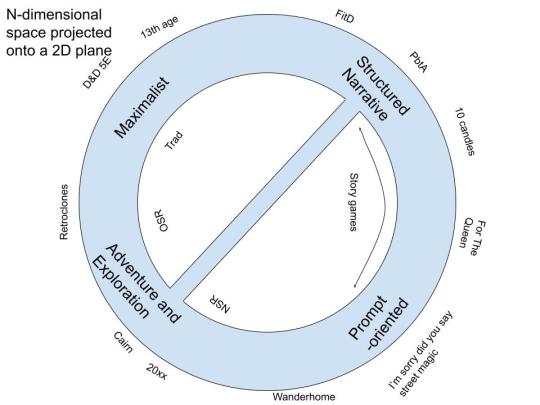
Posted here: https://seedlinggames.com/blogging/discourse/game_taxonomy_part_1_v_1.html I have a second blog post that is going to explain the small diagonal line, but basically it's that I think there is influence between those two camps that people don't seem to talk about much, probably due to internet discourse reasons
A million people have already done this - I'm kind of assuming you have vaguely absorbed the existing Internet discussions, and are familiar with terms like OSR, Story Games, etc. If you haven't, run away now and save yourself. But Six Cultures Of Play is probably a prerequisite to understand what I'm talking about, or at least what I'm complaining about.
I will try to, as much as possible, only discuss games that I have played. A lot of taxonomies seem to be written by someone who clearly likes one type of game a lot more than the others. For instance, I will not be discussing LARP because I don't have any relevant experience. I'm also not claiming that I am discussing the complete set of all games that exist, but I think I have played enough of them propose a taxonomy. If you're curious, I have an approximately complete list of games I've played or run here.
What is a TTRPG?
First we're going to have to look at everyone's other least favourite subject of conversation.
TTRPGs have 2 or more people taking on the following 3 roles:
A player, who is responsible for one or more characters who are the protagonists of the story.
A GM, who is responsible for the remainder of the story, such as providing additional characters and other aspects of the environment that the main players exist in. To do so they might determine the outcome of uncertain events or interpret rules agreed upon by the table.
An author, who provides additional, reusable material without being present. I'm using the term "author" for a lack of a better one, but it includes game books, blog posts, maps, drawings, or even fixed principles transmitted orally from game group to game group. These serve to facilitate or even replace GMing, as well as to introduce new ideas to the table without someone being physically present.
The same person often takes on different roles at different times, sometimes in the same game.
If you have only one of these roles, you are probably writing a book, doing improv, or some other activity. Which is of course totally fine.
This isn't the only definition you could come up with, but I think most people would agree it isn't totally wrong, and it's a lens that I'll be using to discuss the game taxonomy.
Maximalist Games
Apparently "maximalist" means something specific in art but I am not educated in such things and might be using the word wrong.
Characteristics of a maximalist game:
The three roles: clearly present and distinct, with the GM and author each taking on a large responsibility for the game experience.
Modularity: Semi-modular: There is a main game system which is designed to be extended by other modules, but these modules cannot be used with other games easily. A game book is typically not a self-contained experience and games are usually open-ended in duration.
Rules: A lengthy, complex ruleset with subsystems for resolving different parts of the game that are likely to come up, primarily oriented around the success or failure of an action and its consequences.
Characters: The complex game mechanics provide an opportunity for players to develop a distinct character before playing them, defined by game mechanics. Character and player motivations are usually aligned.
Narrative structure: Campaigns usually follow conventional narrative structure, but this is driven primarily by the GM, or by adventure modules, which define an outline of the narrative.
Who makes them: Often require more resources to create and thus are made by corporations, but that is changing.
Relationship to other media: While often inspired by fantasy novels, their larger budget and longer history has allowed some of them to develop their own genre conventions distinct from other media, and in some cases have inspired movies and books.
Solo games: Rare, due to the prominent role of the GM.
"Trad" games are a subset of these but a) I hate that word and b) I think the genre, starting especially with 4E and other inspired games, have gone in some very different directions. It roughly corresponds to "Fight D&D" in the Between Two Cairns taxonomy, but some games in this category involve no fighting at all.
Narrative Mechanics Games
The three roles: Blur the lines between GM and player more freely.
Modularity: Usually not very. Each game is made to create a specific experience, and the blurring of GM and player roles makes adding external content more complicated.
Rules: Focused on resolving problems in the context of narrative structures. Rules may facilitate pacing, allow for storytelling outside of linear time, allow players to temporarily take on a GM-like role, and allow for players to work together to create conflict between their characters.
Characters: Mechanics facilitate creating characters according to genre conventions with defined relationships to other characters and to NPCs. Player and character motivations are often not aligned.
Narrative structure: Rules are designed to support conventional narrative structures and genre conventions.
Who makes them: The focused scope of these games mean that they are often made by individuals rather than corporations, but there is a trend towards some of them being made by mid-sized organizations. Long development cycles may be needed to provide a polished experience, leading to some amount of professionalization.
Relationship to other media: Usually strongly inspired by other media, allowing you to create stories similar to movies, books, TV shows, etc.
Solo games: Rare, with Ironsworn as a notable exception.
Some "story games" fall into this, but I think "story games" has split into two meaningfully distinct categories. I've met enough people who only like one of the two categories. I think they are perceived as more similar than they are because there's less internet drama about the difference between them.
Prompt-based storytelling
The three roles: Blur the lines between the GM, player and author, with the GM often being absent.
Modularity: Usually self-contained experiences with limited modularity.
Rules: Often entirely forego mechanics for failure or success; mechanics tend to be minimal and about making suggestions regarding the story to tell, with the written text sometimes acting primarily as a GM or even player who is not present.
Characters: Character creation is usually a minor to nonexistent part of the game, with characters being defined by decisions made at the table. In some cases, all characters are already predefined. Characters are usually defined in words rather than numbers. Player and character motivations are rarely aligned.
Narrative structure: Stories often forego conventional narrative structures, and are focused around exploring relationships, ideas, or experiences. If a narrative structure is defined, it is usually in the form of a defined endpoint, with the purpose of the game being to explore how the characters get there.
Who makes them: Leans heavily towards DIY or single creators. Often comes in formats other than books.
Relationship to other media: Inspiration comes less from established genres and more from life experiences. Genre fiction is less likely to be an inspiration.
Solo games: Very common, due to the reduced role of the GM.
Adventure/exploration games
The three roles: Blur the lines between GM and author, both at the table and culturally.
Modularity: Are highly modular: not only are supplements and adventures often interchangeable, but are often not tied to specific systems.
Rules: Have relatively short rulesets focused on generating situations (on the GM side) and resolving danger (on the player side).
Characters: Characters are mostly created organically in play through interactions with the environment, including the tools at their disposal. Random generation is common. Character and player motivations are usually aligned.
Narrative structure: Campaigns often do not follow a typical narrative structure, aside from perhaps an escalation in danger, scope and/or strangeness.
Who makes them: Their modular nature means that they are often created in a DIY manner, through zines, blog posts, and informal discussions, though mid-size companies are also prevalent.
Relationship to other media: Inspiration from other media is often mostly vibes-based, with genre fiction, folklore, and even musical genres and political movements (for better or worse) being prominent. It doesn't seek to emulate the characters or narrative structure of other genres.
Solo games: Relatively common, usually provided by an additional module that may be specific and general-purpose, often focused on a GM emulator known as an "oracle."
"OSR" games are a subset of these, but a good number of these also make many OSR people very angry. It roughly corresponds to "Door D&D", but dungeon crawling is not inherent to this genre.
Other ways of looking at these categories
You could also map these on axes:
distinct GM/player/writer role vs combined roles: maximalist vs prompt-based at opposite ends of this spectrum
Highly self-contained vs highly modular: narrative vs adventure/exploration
Strong genre conventions vs naturalistic approach: maximalist/narrative vs adventure/exploration/prompt based
Resembles a D&D vs does not really resemble a D&D: maximalist/adventure/exploration vs narrative/prompt based
for symmetry I want to put another axis for maximalist/prompt based but I can't think of anything they have in common. Oh well.
But I also don't think this is a complete enumeration of all possible types of games either - this is some kind of n-dimensional space that has only 4 blobs on it
The part of the taxonomy blog post where you realize this is actually just me going on about my own preferences this entire time
I've played and enjoyed all 4 types of games, but putting this together has helped me figure something out - why it is that I like both the NSR side of OSR games and like the "super weird" story games. And why I don't seem to be the only one, even though these are often talked about as opposites. Because if you split story games into two genres, the similarities between prompt-based games and adventure/exploration games comes out.
55 notes
·
View notes
Text
SysNotes devlog 1
Hiya! We're a web developer by trade and we wanted to build ourselves a web-app to manage our system and to get to know each other better. We thought it would be fun to make a sort of a devlog on this blog to show off the development! The working title of this project is SysNotes (but better ideas are welcome!)

What SysNotes is✅:
A place to store profiles of all of our parts
A tool to figure out who is in front
A way to explore our inner world
A private chat similar to PluralKit
A way to combine info about our system with info about our OCs etc as an all-encompassing "brain-world" management system
A personal and tailor-made tool made for our needs
What SysNotes is not❌:
A fronting tracker (we see no need for it in our system)
A social media where users can interact (but we're open to make it so if people are interested)
A public platform that can be used by others (we don't have much experience actually hosting web-apps, but will consider it if there is enough interest!)
An offline app
So if this sounds interesting to you, you can find the first devlog below the cut (it's a long one!):
(I have used word highlighting and emojis as it helps me read large chunks of text, I hope it's alright with y'all!)
Tech stack & setup (feel free to skip if you don't care!)
The project is set up using:
Database: MySQL 8.4.3
Language: PHP 8.3
Framework: Laravel 10 with Breeze (authentication and user accounts) and Livewire 3 (front end integration)
Styling: Tailwind v4
I tried to set up Laragon to easily run the backend, but I ran into issues so I'm just running "php artisan serve" for now and using Laragon to run the DB. Also I'm compiling styles in real time with "npm run dev". Speaking of the DB, I just migrated the default auth tables for now. I will be making app-related DB tables in the next devlog. The awesome thing about Laravel is its Breeze starter kit, which gives you fully functioning authentication and basic account management out of the box, as well as optional Livewire to integrate server-side processing into HTML in the sexiest way. This means that I could get all the boring stuff out of the way with one terminal command. Win!
Styling and layout (for the UI nerds - you can skip this too!)
I changed the default accent color from purple to orange (personal preference) and used an emoji as a placeholder for the logo. I actually kinda like the emoji AS a logo so I might keep it.
Laravel Breeze came with a basic dashboard page, which I expanded with a few containers for the different sections of the page. I made use of the components that come with Breeze to reuse code for buttons etc throughout the code, and made new components as the need arose. Man, I love clean code 😌
I liked the dotted default Laravel page background, so I added it to the dashboard to create the look of a bullet journal. I like the journal-type visuals for this project as it goes with the theme of a notebook/file. I found the code for it here.
I also added some placeholder menu items for the pages that I would like to have in the app - Profile, (Inner) World, Front Decider, and Chat.

i ran into an issue dynamically building Tailwind classes such as class="bg-{{$activeStatus['color']}}-400" - turns out dynamically-created classes aren't supported, even if they're constructed in the component rather than the blade file. You learn something new every day huh…

Also, coming from Tailwind v3, "ps-*" and "pe-*" were confusing to get used to since my muscle memory is "pl-*" and "pr-*" 😂
Feature 1: Profiles page - proof of concept
This is a page where each alter's profiles will be displayed. You can switch between the profiles by clicking on each person's name. The current profile is highlighted in the list using a pale orange colour.

The logic for the profiles functionality uses a Livewire component called Profiles, which loads profile data and passes it into the blade view to be displayed. It also handles logic such as switching between the profiles and formatting data. Currently, the data is hardcoded into the component using an associative array, but I will be converting it to use the database in the next devlog.

New profile (TBC)
You will be able to create new profiles on the same page (this is yet to be implemented). My vision is that the New Alter form will unfold under the button, and fold back up again once the form has been submitted.
Alter name, pronouns, status
The most interesting component here is the status, which is currently set to a hardcoded list of "active", "dormant", and "unknown". However, I envision this to be a customisable list where I can add new statuses to the list from a settings menu (yet to be implemented).




Alter image
I wanted the folder that contained alter images and other assets to be outside of my Laravel project, in the Pictures folder of my operating system. I wanted to do this so that I can back up the assets folder whenever I back up my Pictures folder lol (not for adding/deleting the files - this all happens through the app to maintain data integrity!). However, I learned that Laravel does not support that and it will not be able to see my files because they are external. I found a workaround by using symbolic links (symlinks) 🔗. Basically, they allow to have one folder of identical contents in more than one place. I ran "mklink /D [external path] [internal path]" to create the symlink between my Pictures folder and Laravel's internal assets folder, so that any files that I add to my Pictures folder automatically copy over to Laravel's folder. I changed a couple lines in filesystems.php to point to the symlinked folder:

And I was also getting a "404 file not found" error - I think the issue was because the port wasn't originally specified. I changed the base app URL to the localhost IP address in .env:

…And after all this messing around, it works!
(My Pictures folder)

(My Laravel storage)

(And here is Alice's photo displayed - dw I DO know Ibuki's actual name)

Alter description and history
The description and history fields support HTML, so I can format these fields however I like, and add custom features like tables and bullet point lists.

This is done by using blade's HTML preservation tags "{!! !!}" as opposed to the plain text tags "{{ }}".
(Here I define Alice's description contents)


(And here I insert them into the template)

Traits, likes, dislikes, front triggers
These are saved as separate lists and rendered as fun badges. These will be used in the Front Decider (anyone has a better name for it?? 🤔) tool to help me identify which alter "I" am as it's a big struggle for us. Front Decider will work similar to FlowCharty.

What next?
There's lots more things I want to do with SysNotes! But I will take it one step at a time - here is the plan for the next devlog:
Setting up database tables for the profile data
Adding the "New Profile" form so I can create alters from within the app
Adding ability to edit each field on the profile
I tried my best to explain my work process in a way that wold somewhat make sense to non-coders - if you have any feedback for the future format of these devlogs, let me know!
~~~~~~~~~~~~~~~~~~
Disclaimers:
I have not used AI in the making of this app and I do NOT support the Vibe Coding mind virus that is currently on the loose. Programming is a form of art, and I will defend manual coding until the day I die.
Any alter data found in the screenshots is dummy data that does not represent our actual system.
I will not be making the code publicly available until it is a bit more fleshed out, this so far is just a trial for a concept I had bouncing around my head over the weekend.
We are SYSCOURSE NEUTRAL! Please don't start fights under this post
#sysnotes devlog#plurality#plural system#did#osdd#programming#whoever is fronting is typing like a millenial i am so sorry#also when i say “i” its because i'm not sure who fronted this entire time!#our syskid came up with the idea but i can't feel them so who knows who actually coded it#this is why we need the front decider tool lol
14 notes
·
View notes
Text
Alright, so bear with me.
Humans have three cone cells in our eyes that are how we perceive color in the world. I often think red, green, and blue, but apparently people studying them use Long, Medium, and Short to be unambiguous (just for one example, if you activate M really strongly and not L or S, the color people report seeing is yellow-green). Each type activates at different strengths to different wavelengths of light. Here's a lovely graphic from Wikipedia showing response levels of each cone type to different wavelengths:

So you can see that if some light activates L some, but not M, we'll perceive deep red, activates them both a bit, we see orange or yellow, depending on the specific amount.
It's interesting that some effect (a specific mix of pigments, or some structural coloration) could be producing some mostly 495nm light, or a blend of some slightly higher and slightly lower wavelengths, and either way we see cyan. (And a good thing, too, otherwise our display technology would be extremely unconvincing.)
Of course, then there's what happens when we get activation of L and S at once, but not M, our eye-brain systems don't infer "yellow-green", because green is specifically what's missing from there: we generate magenta, a non-spectral color. (And when all three activate we get white, of course.)
I found myself thinking about birds, with their four cones.
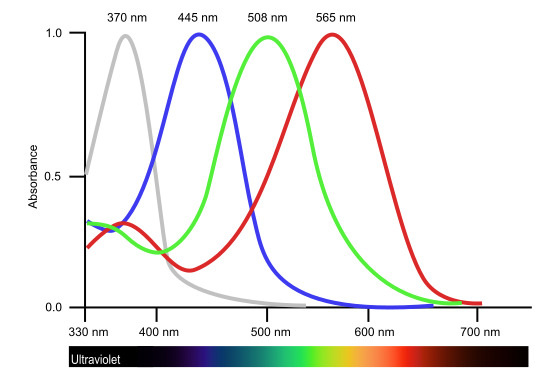
They're more evenly spaced too, the bastards. (These bastards are specifically finches but I'm under the impression that most birds are similar.)
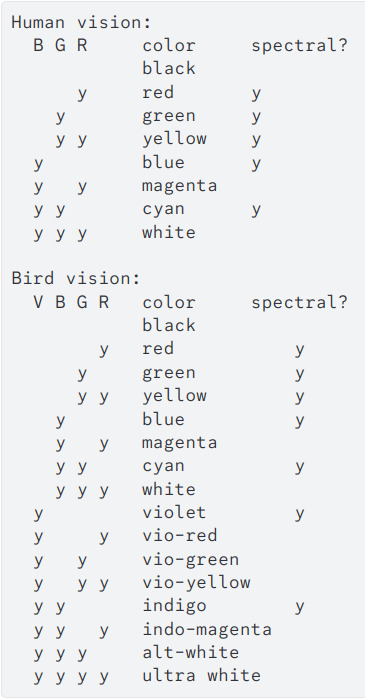
(Of course, "violet" actually means ultra-violet here. Look at the graphic, their UV cone stops responding where our S cone starts. I would edit this, but spent like half an hour discovering that tumblr doesn't support table under html or code/"preserve formatting" under markdown anymore; so you get a screencap of what I sent on discord.)
Birds could see "vio-green" (accepting name suggestions) as a color region as distinct from blue/indigo as green is from purple/magenta.
Look at that. Two whole ass independent spectral color divisions we don't have, and six non-spectral inferences. Eight whole categories of visual perception more than us. Decadent.
The heart quails to imagine what the 16 color receptors of a mantis shrimp would create. I mean, okay, it doesn't because we've studied their eyes and brains and they don't blend colors the way we do, smooshing them down to a much simpler set of perceptions.
But imagine if we rebuilt our eyes and brains for it! Color indicates chemistry, with that level of subtle blending of characteristics, would vision become like tasting everything we look at?
Please pet the bear that is with me on your way out.
#original#transhumanism#long post#I have not actually studied the perceptual systems of birds in any detail so take this with a grain of salt#regretting alt-white now that I've said it aloud in my head#edited: spat this out so fast I miswrote something under the bird spectrum image; also missed a 'd' in 'spaced'
67 notes
·
View notes
Note
GIRL CODED JASON !!!!! HI HELLO OMG TUMBLR USER AND AMAZING AO3 WRITER GHOST BIRD YOUR POSTS AND STORIES JUST ACTIVATE BRAINWORMS IN MY HEAD 😭😭😭😭 holy fuck hi I'm too shy to come off anon but I love the discussions you've been having, so just chipping in !!!
I love the many many looks on how people interpret him being girl-coded, exploring his feelings towards domestic violence, towards victims, women etc, extremely good points that you brought up ! And I'd like to bring up that on a more meta level, the way his character is treated by DC and by people in canon as a whole is also so... girl-coded ? Going to try my best to articulate since eng is my 3rd language 😔😔 Sorry if it's not consise 😭😭 I have FEELINGS AAAAAAAAAAAA
I think the core of this "girl-codedness" stems from a few things, two things I can point to currently are how he's treated as a victim and fridging. Fridging is the easier one to see imo, it's something that's usually associated with female characters but fits Jason a lot. It's not about him and his trauma/pain being feminine inherently (nothing can be categorised in that way honestly) but how it's dealt with by people and the narrative.
Let's take a look at its counterpart which is 'Dead Men Defrosting' trope coined by John Barton. Here's the source for that: https://www.lby3.com/wir/r-jbartol2.html, and a quote from the Women in Refridgerators website I feel is really encapsulates this whole situation.
"...women heroes are altered again and never allowed, as male heroes usually are, the chance to return to their original heroic states. And that's where we begin to see the difference."
Sounds familiar, doesn't it? Additionally, the grief that his death bought is made to be even more objectifying than it should have been. It's made to be Bruce's and everyone else's more than it is Jason's. The image of the dead character is, by necessity, distorted and is served as fuel towards a different character. He's reduced to his death and the pain associated with it is milked for like... 16 yearsish??? A perverted memorial, a perverted memory, an altered legacy. He was just 15. A boy. (Still, I wouldn't say Jason was fridged per say, as the term is created in reference to female characters and they have little to no agency in their stories there, but that 'feel' is there. So I understand where the girl-codedness comes from!)
It’s that the way a lot of characters treat him and a lot of the tropes used on him are things that are typically associated with feminine characters. It's also about how he's treated since he's not a perfect victim. Every attempt Jason has made to express his pain and his anger just gets him labelled as emotional, unreasonable and hysterical (which are again, unfortunately terms associated with women.)
There's many different points people have brought up about Jason, such as his bleeding compassion as Robin, the tears at the end of UTRH, and so on. Nonetheless, I think there's a lot of nuance that comes with gender discussions, since these things are deeply personal to people, and there's disagreements to be had. And that's cool !! There's many points loads of other people also being to the table that I love !! Contradictions too !!
Anyhow, so many cool PPL and analysis these days,,, ILY ANON WHO BROUGHT UP TITANS TOWER (anonanonanon pls chip in again and my life will be URS) Also ILY TUMBLR USER MAGIC-CRAZY-AS-THIS FOR PUTTING THE WEDDING DRESS IMAGERY IN MY HEAD, ALSO ILY GHOSTBIRD FOR THAT AMAZING REPLY AND ANALYSIS,, I LOVE THIS LITTLE POCKET OF COMMUNITY U HAVE CREATED this is so beloved 🥺🥺🥺💞💞💞💞
All very good points!
I don’t have much to add here except perhaps the argument with the memorial case. You’re absolutely right. I never realized how similar it is to the classic hero trope of protagonist mourning their dead love interest/family and dedicating their entire life to a memory of them, citing the actions they take to be in honor of the dead person.
On one hand, I tend to enjoy that trope. On the other hand with Jason, it all became horribly twisted so very quickly and lead to a hard downward spiral of Bruce having a real assholish phase.
But yeah that’s a whole other can of worms better left unopened for now ksksks.
I’m very happy you’re enjoying this blog 💚 it’s honestly super rewarding to hear people say that when it was one of the main goals to have this be a safe and harmonious space for everyone 💚💚✨
#ghost talks#personal opinion#by no way right or wrong just… existing#obviously it’s also to okay if someone here doesn’t like Jason at all!#totally valid#although with how much I gush about Jason very unlikely around here kskskskks#fandom and ship positivity#harmonious vibes#and a healthy approach to fiction and online interaction#batfamily
32 notes
·
View notes
Text
9-1-1 Characters: AO3 works per episode
More info, methodology, and the numbers below the cut.

This chart was created with data from AO3, including locked works, from about 9:00 p.m. EDT on 3/28/2025. As lovely creators are always adding new works, it is almost certainly out of date. The bars are color coded by character type: blue for main, yellow for love interests, green for family, purple for other first responders. What does this chart tell us? Good question. A reasonable person might conjecture that characters who appear on the show more often are written about more often, and so by controlling for that, we might see some interesting trends. Waaaay too many confounding variables to draw any kind of rigorous conclusions, but it's interesting nonetheless. I do feel comfortable in saying our dispatch friends need more love <3. Methodology: This divides # of works listed in that character's AO3 tag, by the # of episodes that character has appeared in per IMDb. So a character that appears in two episodes, and has 200 works, would have a WPE of 100. WPE is rounded to the nearest whole number. There's always some subjectivity on who to include, but I tried to give a balance between love interests, family members, and first responders, along with anyone who is or was a main (which does include Albert! I remember season 4). Family members tended to be close together, hence why you don't see Ramon or Margaret - they're so close to their spouse it just felt redundant. I fought the html gods to insert this as a table and not just an image, but they won. Many apologies. % of works is the number of works the character is tagged in divided by the total number of works in the 9-1-1 fandom tag.

#911 abc#tommy kinard#911 fanfic#911 on abc#911 on ao3#stormy does stats#fic stats#adriana diaz#ok i have to admit when i was running this i started laughing at tommy and adrianas WPE#like so high and not a main amazing
17 notes
·
View notes
Text
Sugary Scribbles | #8
Saturday 6th January 2024
IT'S BASICALLY WORKING (on larger screens)! My never-ending war on website responsiveness continues! I have a large screen and I stupidly only took into account of MY screen size. What I did do though is created a message for phone-table sizes because it just wouldn't make sense it working on really small devices - in my opinion~! But for now I will put this on hold because I am excited about my other project idea I came up with yesterday oops~!
This is my first project of the year and it's super adorable in my opinion! It paints, it erases, it deletes and it saves your artwork! Ticks all the boxes I made at the beginning of the project! Turned a simple 'Make a HTML painting webpage' into something more cuter and cool! Job well done! 😩🙌🏾💗
You can try it out (if you have a larger screen size), all that happens is the painting will be off the mouse direction a bit, sorry!
link to the Sugary-Scribbles web app! 🍡

Lastly, here is a cool drawing I made as I was testing the site~! I'm a better artist than this I swear, just not good using a mouse...

List of resources I used during the project
Figma - to plan the webpage
Canva: to make the header
Photopea: for further photo editing
RedKetchup: to colour pick quickly
CSS Animations: to add the zoom-in-n-out animation
MDN Canvas: to know what the element does properly
YouTube Tutorial: to get inspiration and extra help
Flaticon: for the icons and cursors
Html2canvas API: to turn the drawing into an image (tutorial)

That's all, have a nice day/night and happy coding! 🖤
#xc: project logs#sugary scribbles project#codeblr#coding#programming#progblr#studying#studyblr#dev logs#comp sci#computer science#programmer#devlogs#html css#javascript#tech#cute#adorable
102 notes
·
View notes
Text
You know that spreadsheet I made? It's got an upgrade. Same information (with some errors fixed), but actually presentable now! Because surprisingly, it turns out that my friend, who is actually knowledgable about IT and used proper web design tools, can make a better looking site than I did by creating an Excel spreadsheet, copying the text into Notepad, adding HTML tags, and uploading the table to some free site that will let you host a single HTML page there.
Seriously, it's awesome. I'm quite enjoying looking at it. It's got a search function that lets you narrow results and actually works. All the links are still there. The text is way more readable, with things like different colours involved (I was going to put colour on my HTML page, but it seemed like too much effort to figure out).
And once again, I would like to say, to Andy Zaltzman, who came on The Bugle and announced that he'd looked up the Chocolate Milk Gang and was confused by the result: the work's been done for you, Andy! And for anyone else who wants it! No one else needs to spend dozens and dozens of hours across several years Googling this odd niche, because I've already done it! And I have a friend who knows how to do websites, so now it's even readable:
This page is going along with a larger archive that's currently under construction, but the whole thing is going to be really cool, archiving comedy is cool and useful. Although if Kitson ever manages to stumble across it, I will deny having any involvement with that archive, or, in fact, ever having heard of Kaniel Ditson.
10 notes
·
View notes
Text
webdev log uhhhh... 6?
Haven't worked on my site in a bit because I think I fucked up somewhere in during the deployment phase so now it's hard to host it locally.... only the index page works and the css is half broken anyways, presumably because of laravel breeze's tailwind coming preinstalled. I DID have to jump through hoops to get it going during deployment.. just don't know which hoops so it's stuck that way >_>;; so now I can't host it locally for development......... I'll have to make things and just hope it shows up when I deploy them I think
Failed to listen on 127.0.0.1:8000 (reason: ?)
cool, cool. thanks. very helpful debugging message..
anyways, coded up a little php doohicky and updated my site! WANNA PEEK?
I wanted to migrate my fridge page (art others have done of my characters) to my site, but I didn't want to implement another table because YUCK I'm so done with that.
I wanted something more automatic because I'm lazy and I also wanted it to not look like it's from 2003 like my neocities to match with my new site. too much trouble!!!! including the stuff previously mentioned.. so I left it untouched for a while.
then I was talking with someone and wanted to try making this with php.....

it's pretty basic. finished the code for the script in like an hour maybe, and then later it was mostly just tinkering with the html/css itself to make it display all nice and grid-like.
all it does is take all images from a specified folder and spits them out.
it creates a DirectoryIterator object to iterate through the specified folder (at least, I think that's how DirectoryIterator works.... dunno) then for each individual file it checks if it's an image, gets the time the file was modified, then stores the file path and modified time in an array. then that array gets sorted via modified time (newest first), and then iterated through and BAM...
I'd prefer a better time system such as organize when the file was actually created, but if you paste a file into a new folder, "created time" gets changed to when you pasted it.. using file modified time is the only way when you aren't using a database and just want this to be all done automatically I think. unless I'M STUPID and someone has a better idea.. then please enlighten me.
ANYWAYS added The Fridge to my site using my lil code! :>

updated my About to include a link too...
also, I was looking up things and found this funny example code on stack overflow

let's all randomize our racism images.....
5 notes
·
View notes
Text
There is something very weird about the relatively short nature of the culture surrounding website creation. As in, like, internet-user-created websites have been around for like 30-31 years at this point, and the culture surrounding them has changed so very much.
People used to create websites left and right for their own needs, their little shops and their little blogs about what they liked. Some websites of course housing horrible content since their dawn, and some being as mundane but as unique as the person behind its code. I have seen older sites, archived, that promoted creating your own site, and that was interesting to see. That culture of creating your own website and of sharing that knowledge on a still-growing facet of communication.
And then at some point social media appeared, and that was interesting, because now everyone was able to quickly present themselves without the need of a website, but that didn't mean people stopped making websites. I mean, hell, Geocities died in 2009, so a lot of people were creating their own websites for free before that time, no need to pay for domain names or hosting. And even without Geocities, there were other website hosting things that yes, while not as customizable, were still a resource for people to work with them. There's still a website floating around that I made when I was a kid using one of these services. Cool stuff.
All this to say that I do feel a weird sense of dread looking back and cross-referencing with the present and seeing things like "website creator powered by AI" and shit like that, because just ?? How did it go plummeting so quickly. There is a weird feeling of having lost a developing culture to corporations making quick access to posting things that, as corporations' nature dictates, are used to sell data or to train models or what have you. Similarly, we get pretty same-y looking pages because of the need to be slick or whatever with designs that just leaves everything looking the same. ALSO, the loss of spaces for kids, or just the gradual lowering of them in favor of cocomelons and whatever else the devil's machine has spawned is like watching an apple decay before having ripened. I do feel like there is this phenomenon in which how to make a site has been lost in the notion of "making a website falls into the realm of evil and scary coding and I could never be a programmer, plus who would look at it, plus we have tools to make them," etc etc etc. Here is a little secret: website creation is not exactly hard to pick up at all. You might say it's very similar to using a rich text editor like Word or a notes app or whatever you use. Similarly, have you used markdown for things like messages or D iscord messages, you know, with the asterisks for bold text and the likes? Markdown is based on html's structures. And truly, you do not have to even learn to code using Javascript if you don't want to, you can just go full html + css and structure your things as you go, adding your little images and your updates. Because guess what !! Html and css are not programming languages, they're a markup language and a stylesheet language respectively, which is a fancy way to say "you make the structure of your page with the first one and make it pretty with the second one". This includes cool stuff like tables, lists, grids, colors, transitions, etc. All of that without any programming. (That being said, if you are interested in programming, Javascript isn't too bad to pick up. The language itself *is* kind of evil, but using it in conjunction with html is not too difficult). I do have to say though, I am glad that there is a push to making your own websites and things, especially with Neocities sprawling a huge community of avid website creators, as well as the huge amount of tutorials and stuff making the push forward with making sites and online spaces and experiences more widely available. Hopefully this becomes a trend that keeps going up, considering the state of seemingly every single social media that has existed since the 2000s- 2010s.
#web#website#old web#dog discourse#ramblings#internet#computer#tech#but for real what the fuck#it's very bizarre to see this just pop in and out
7 notes
·
View notes
Text
launching my personal website!
finally, it is here: the website i created, powered by astro and github books!
currently featuring:
dark mode toggle
mobile friendly layouts
reader controls on my project pages
auto-generated links and layouts for new chapters in each project
css only menu drop downs & table of contents sidebar
some cool google fonts
a few of my favorite bug glyphs (mostly on desktop/tablet)!
i'll be using this website to host my personal projects, including my writing projects, comics, and perhaps a gallery of personal art unconnected to any larger theme.
roadmap:
autogenerated page descriptions in html head, for better previewing
rss feed
more commenting options
guestbook
and perhaps... more?!
come take a look at my website, i'd love to know what you think! :] you can always ask me about how i implemented features on my website -- i would more than welcome the opportunity to gab.
thanks for stopping by!
3 notes
·
View notes
Text
Responsive Sortable Table for HTML Websites
People watch website both from Laptop and Mobile. So, when a web developer creates Table, he or she should make it as responsive. Sometimes it is important to set different color for odd and even row that reader can read the table easily. This Code can make your Table Header sortable too.
#HTML#HTML website#CSS#CSS3#Different Color for Odd and Even Row#Even Row#Filter Table#Filterable Table#Hover on Table Row#Odd Row#Responsive#Responsive CSS Table#Responsive Table#Sortable Table#Table
2 notes
·
View notes
Text
Why Should You Do Web Scraping for python

Web scraping is a valuable skill for Python developers, offering numerous benefits and applications. Here’s why you should consider learning and using web scraping with Python:
1. Automate Data Collection
Web scraping allows you to automate the tedious task of manually collecting data from websites. This can save significant time and effort when dealing with large amounts of data.
2. Gain Access to Real-World Data
Most real-world data exists on websites, often in formats that are not readily available for analysis (e.g., displayed in tables or charts). Web scraping helps extract this data for use in projects like:
Data analysis
Machine learning models
Business intelligence
3. Competitive Edge in Business
Businesses often need to gather insights about:
Competitor pricing
Market trends
Customer reviews Web scraping can help automate these tasks, providing timely and actionable insights.
4. Versatility and Scalability
Python’s ecosystem offers a range of tools and libraries that make web scraping highly adaptable:
BeautifulSoup: For simple HTML parsing.
Scrapy: For building scalable scraping solutions.
Selenium: For handling dynamic, JavaScript-rendered content. This versatility allows you to scrape a wide variety of websites, from static pages to complex web applications.
5. Academic and Research Applications
Researchers can use web scraping to gather datasets from online sources, such as:
Social media platforms
News websites
Scientific publications
This facilitates research in areas like sentiment analysis, trend tracking, and bibliometric studies.
6. Enhance Your Python Skills
Learning web scraping deepens your understanding of Python and related concepts:
HTML and web structures
Data cleaning and processing
API integration
Error handling and debugging
These skills are transferable to other domains, such as data engineering and backend development.
7. Open Opportunities in Data Science
Many data science and machine learning projects require datasets that are not readily available in public repositories. Web scraping empowers you to create custom datasets tailored to specific problems.
8. Real-World Problem Solving
Web scraping enables you to solve real-world problems, such as:
Aggregating product prices for an e-commerce platform.
Monitoring stock market data in real-time.
Collecting job postings to analyze industry demand.
9. Low Barrier to Entry
Python's libraries make web scraping relatively easy to learn. Even beginners can quickly build effective scrapers, making it an excellent entry point into programming or data science.
10. Cost-Effective Data Gathering
Instead of purchasing expensive data services, web scraping allows you to gather the exact data you need at little to no cost, apart from the time and computational resources.
11. Creative Use Cases
Web scraping supports creative projects like:
Building a news aggregator.
Monitoring trends on social media.
Creating a chatbot with up-to-date information.
Caution
While web scraping offers many benefits, it’s essential to use it ethically and responsibly:
Respect websites' terms of service and robots.txt.
Avoid overloading servers with excessive requests.
Ensure compliance with data privacy laws like GDPR or CCPA.
If you'd like guidance on getting started or exploring specific use cases, let me know!
2 notes
·
View notes
Text
I wrote a crazy little web component that displays interactive random tables in HTML.
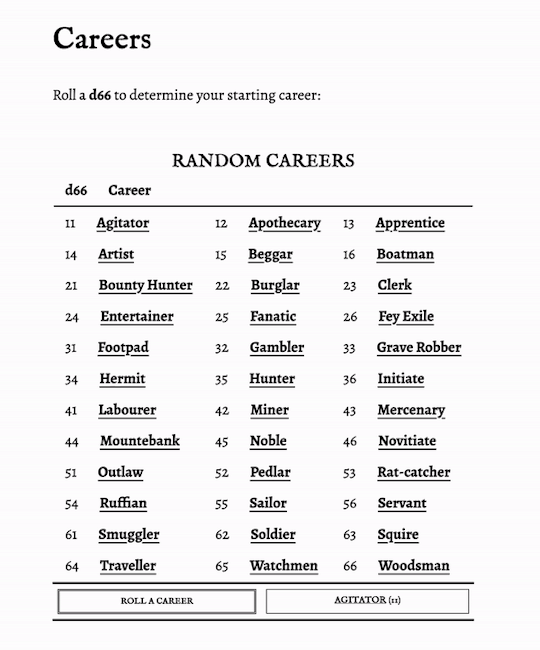
7 notes
·
View notes
Text
How do you publish a comic on ComicFury? A beginner's overview
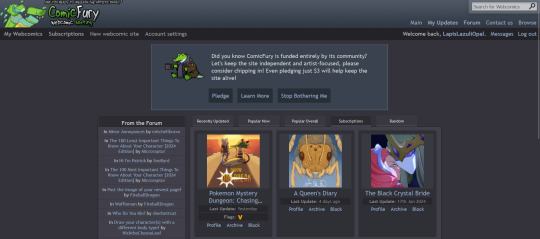
So, you're on ComicFury, see all these cool comics and think you want to make one of your own? Worry not, it's actually pretty easy :D When you have signed up, got accostumed, even subscribed to a few comics, you can go to the "new webcomic site" page to get started
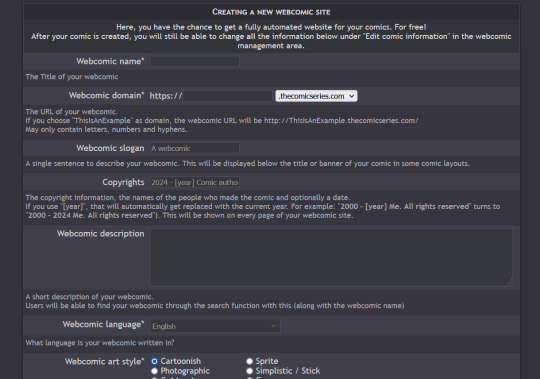
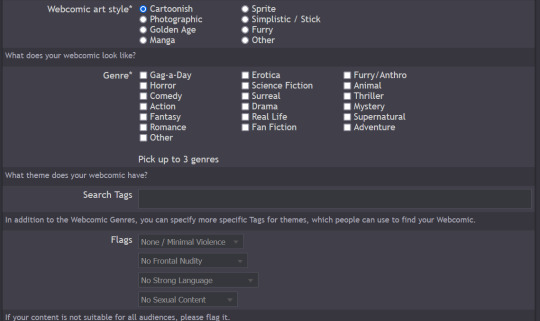
The screenshots cover the whole page, but I will summarize for you: you can chose title, description, slogan, language, style & genre, tags, content warnings and moderation settings (such as allowing comments and ratings)
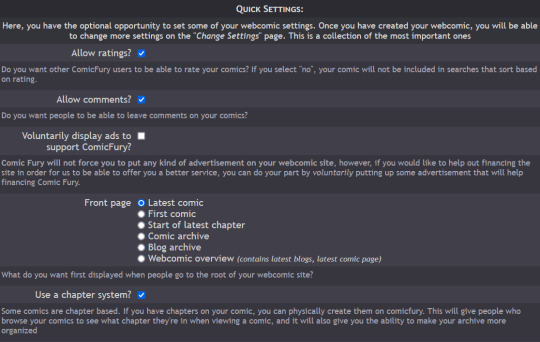

Additionally, you have five different domain options to pick from: .thecomicseries.com, .the-comic.org, .thecomicstrip.org, .webcomic.ws, and .cfw.me

Akin to tumblr's range of default themes to pick from, here you have to pick one default layout you will be able to customize later on (you can also work on the html if you're crafty enough)
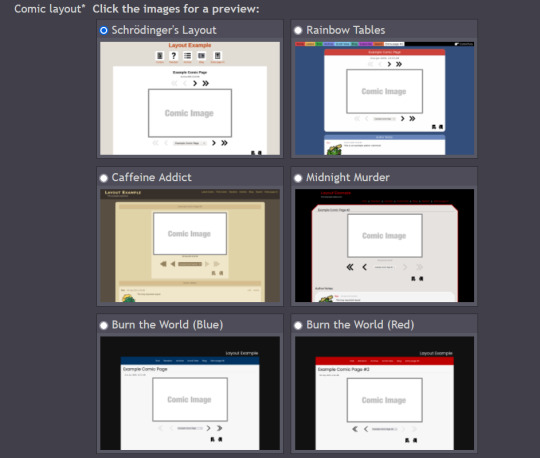
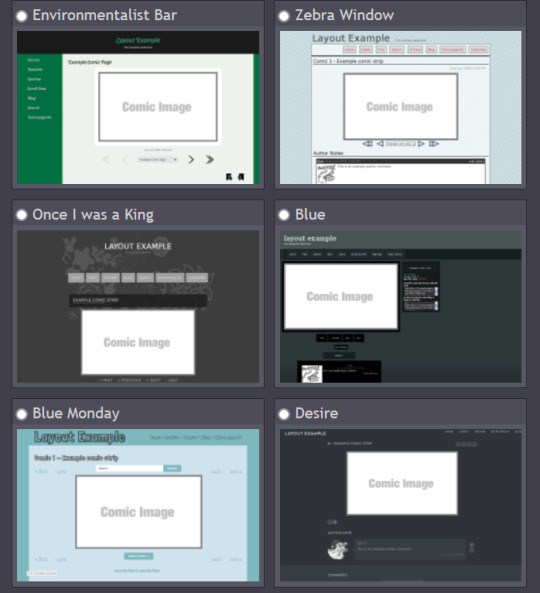
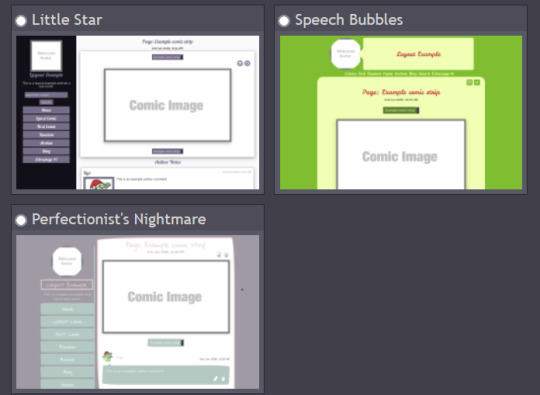
I personally picked "Rainbow Tables" because it already fits well enough the vibes of Wacky Races XD

Once you're done, you will find your webcomic or webcomics (there's no limit on how many webcomic sites you can open as far as I know) in the "My Webcomics" page. Your webcomic will have, in addition, a profile page which will be the first thing people will see when they browse on comicfury
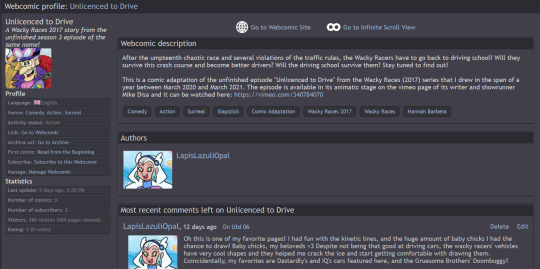
By clicking on "manage webcomic", you can do many things ranging from uploading/editing/scheduling pages to changing the website's layout
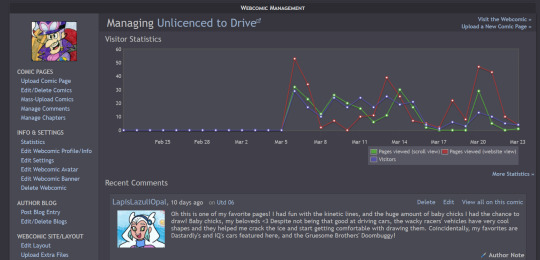

So now you want to upload some pages, right? Here we goooo
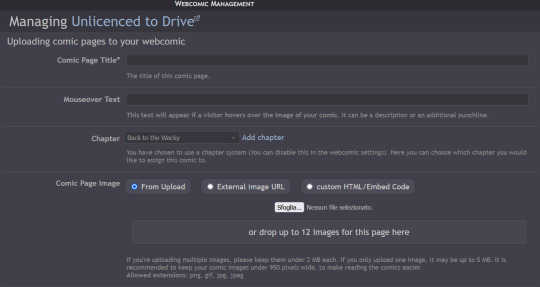
You have to pick a title for the page (could even be just Utd 01, 02 and so on), you can chose a chapter it will belong to (if you want to create chapters) then you can upload up to 12 images in the same page! But remember there's size limits: for multiple images it's maximum 2MB each, for a single image it's maxmimum 5MB. It supports png, gif, jpg and jpeg formats. After putting it some keywords that will make your comic easier to find and adding a transcript of the page if you want, you can upload your page!
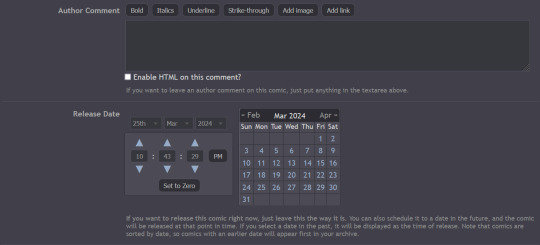

Here's how you can create chapters by clicking on "manage chapters", you pick a name and you can add a description and a cover (that's optional though) As you can see, I have five chapters on my comic for example
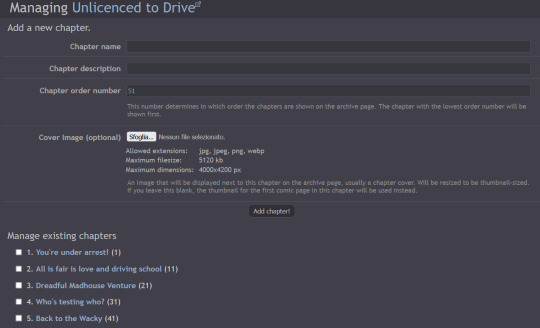
Now that you know the basis you can try it out yourself!! Mind you, it doesn't even have to be a comic, I've seen people create websites to host illustrations made for monthly challenges as well, or other webcomics can be made by photographing action figures, it can really be whatever you want! Have fun out there :D

#ComicFury#webcomics#how to use comicfury#I hope this can help anyone who wants to try out making a webcomic!#comic#webcomic#artists on tumblr#indie comics
6 notes
·
View notes